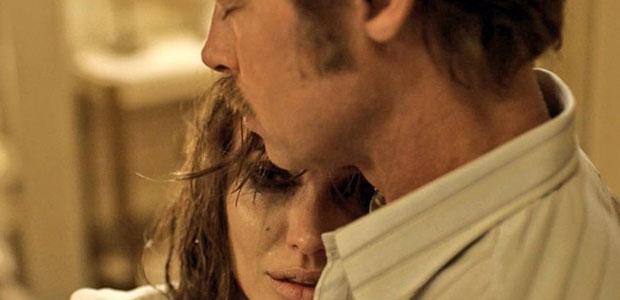In writing and directing By The Sea, Angelina Jolie took on an impressive challenge. The film really is as intimate as movies get – centering on only a handful of individuals, none of whom ever leave a small French town and visit just three distinct locations within it – and such a small-scale narrative requires strong dramatic shifts and character development to keep it moving and afloat. Admirable as the attempt is, however, it’s these two categories in which the feature is lacking, and while the performances are great and the photography is superb, it’s also what ultimately holds the film back in a significant way.
Set in the 1970s in an unnamed village, By The Sea begins with a married couple, Roland (Brad Pitt) and Vanessa (Angelina Jolie), arriving at a quaint hotel where they plan to spend the next few months of their lives. On paper, the mission is for Roland – a writer – to find inspiration for his next work, but the long-betrothed individuals are also there to try and perhaps rehabilitate their marriage. Unfortunately, Roland struggles through his creative block by getting wasted day after day at the local bar, and Vanessa spends her days alone either in the hotel or out for walks along the shore, popping pills and zonking out. It’s only when a younger couple on their honeymoon (Mélanie Laurent, Melvil Poupaud) moves in next door that things begin to shake up between the two leads – and they see their relationship finally start to change.
I choose the word “finally” specifically because the film’s biggest issue is the fact that it doesn’t ever seem to be in a rush to go anywhere with its plot. When I say that we see Roland get wasted day after day and Vanessa spend all her time alone, I mean that we see that on repeat throughout the first half of the movie – often with nothing being added to the story, and just the same character elements being drilled in over and over. And while the second half is an improvement – certainly adding more interesting interactions between the married couple as they begin to reconnect and bond over voyeuristic habits – it still rarely provides the narrative thrusts needed to be continually engaging for the audience. The film's 132-minute runtime is excessive, and it would pack a much greater punch if it received a tighter edit.
The deliberate pace doesn’t do the story any favors in By The Sea, but it certainly does give the film ample time to explore the absolute beauty of the setting. A sharp contrast to the icy and harsh relationship between Roland and Vanessa, the French village and seascapes are breathtaking from every single angle captured, and cinematographer Christian Berger really lets the intense blues, golds, reds and greens explode on screen. This is only aided by the period setting, which removes any ugliness of modernity and replaces it with classic style. As a director, Jolie not only has the wherewithal to embrace her surroundings, but also shows an aptitude for symbolism, peppering the movie with various repeated and significant visuals; and while not every thread placed ultimately leads somewhere, the film does demonstrate the filmmaker’s sharp, developing eye. It’s an eye that seems to need a bit of restraint at times, but it’s definitely an impressive artistic outing.
By The Sea offers Angelina Jolie the first opportunity she’s had to direct herself as an actress – not to mention her first time working with husband Brad Pitt since 2005’s Mr. And Mrs. Smith - but you certainly wouldn’t know it just watching the film. Given that both Jolie and Pitt have spent years as two of the best actors in the business, this should hardly be surprising, but it’s notable simply because their roles aren’t exactly the easiest characters to play. Vanessa – a former dancer obviously dealing with some kind of trauma – isn’t exactly easy to connect to, as she spends most of her time lounging, being cold towards her husband, stoned, or all three at the same time. However, Jolie plays the part with a distinct pain hiding behind her eyes that keeps you curious about how she used to be, and the "why" behind who she has become. As Roland, Pitt has a somewhat easier part to play, as he is really the one actively trying to fix the relationship and therefore immediately becomes more sympathetic. But the star does an amazing job pushing him to unlikable places and challenging the audience to stick with him. The compact, character-driven nature of the film would be a playground for any talented actor, and both of the leads take full advantage.
There is certainly a lot to appreciate about By The Sea, but it doesn’t quite add up to the sum of its parts. Within it, there is an effective dark drama about love in the face of trauma and the struggle to rebuild – boosted by great performances and beautiful aesthetics – but it doesn’t hang together as well as it should, and is undercut by its lack of urgency. Still, it’s certainly an interesting stepping stone for Angelina Jolie’s emerging career as a director, and does succeed in making me curious for what she will do next.

Eric Eisenberg is the Assistant Managing Editor at CinemaBlend. After graduating Boston University and earning a bachelor’s degree in journalism, he took a part-time job as a staff writer for CinemaBlend, and after six months was offered the opportunity to move to Los Angeles and take on a newly created West Coast Editor position. Over a decade later, he's continuing to advance his interests and expertise. In addition to conducting filmmaker interviews and contributing to the news and feature content of the site, Eric also oversees the Movie Reviews section, writes the the weekend box office report (published Sundays), and is the site's resident Stephen King expert. He has two King-related columns.











